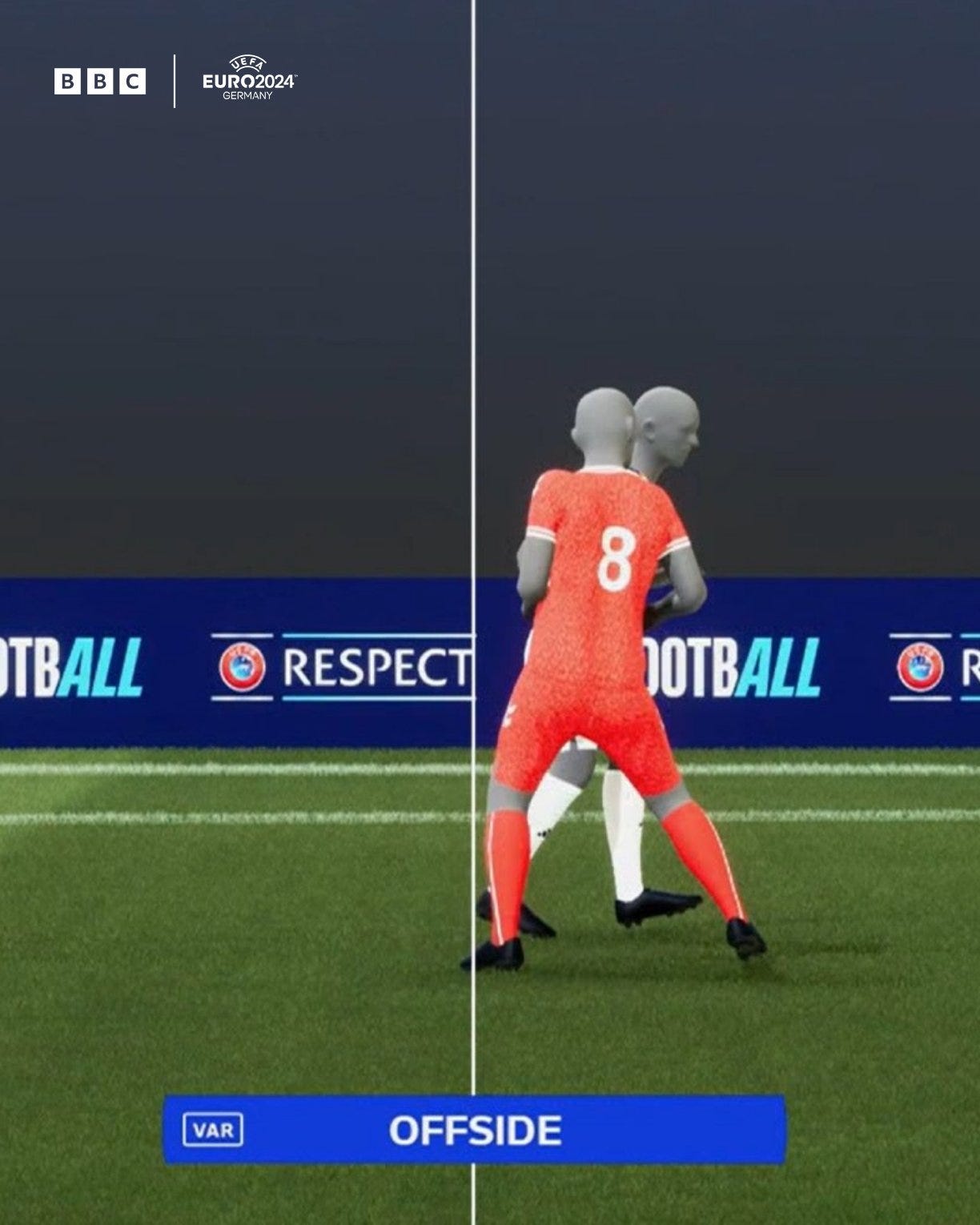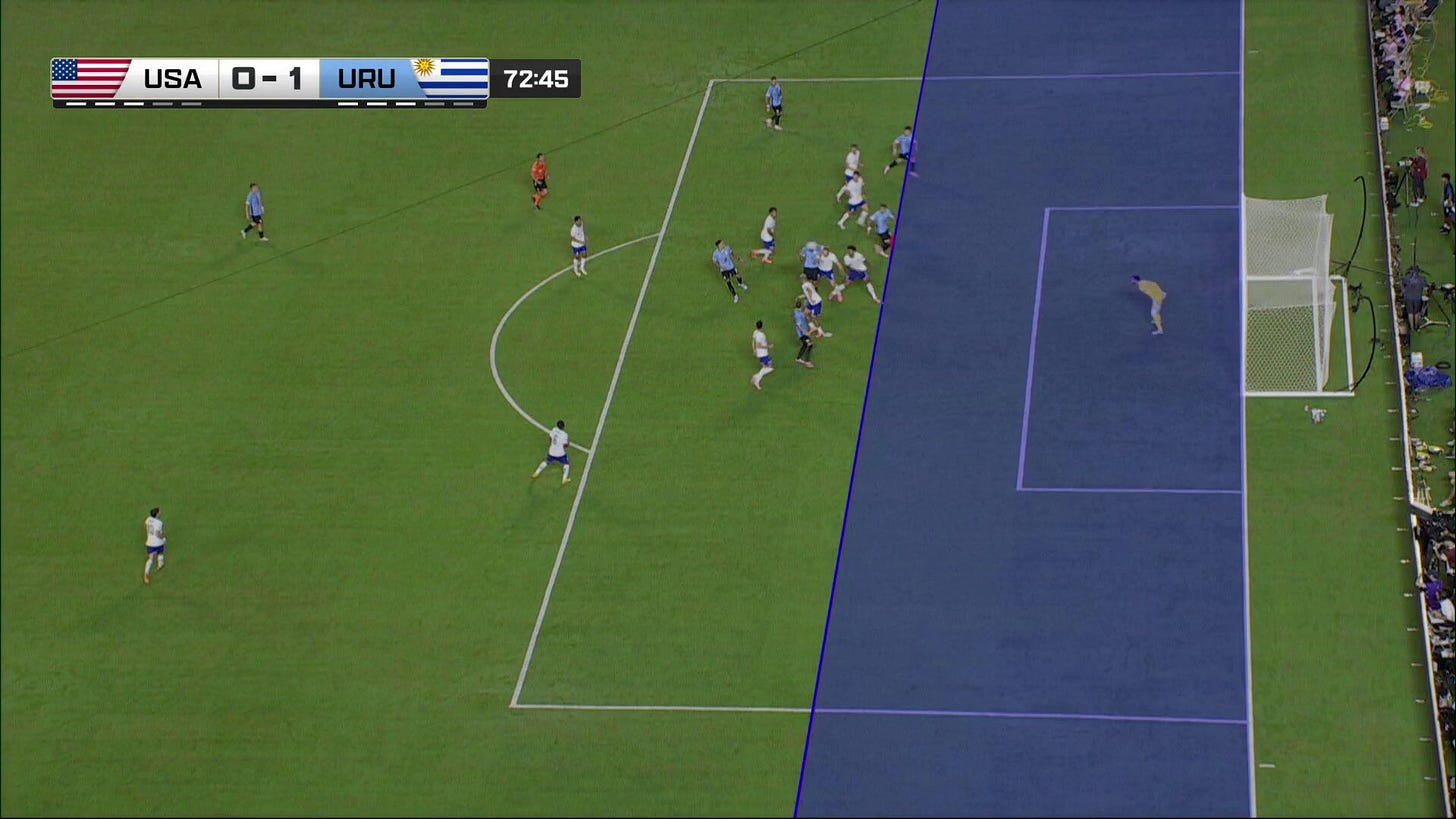Will I ever stop complaining about VAR? Not today
Plus, the Toronto Maple Leafs have been busy not trading Mitch Marner

I am an admitted VAR hater. The introduction of replay technology in soccer offers the promise of objectivity, but instead swaps an on-field referee’s subjective ruling for a different subjective ruling, one determined by an official in a video booth. The system doesn’t guarantee accuracy, but it does kill excitement. I am repeating myself here.
Still, it has been helpful to have two major tournaments, happening concurrently, to underscore the problems with VAR. More than that, the number of incidents at Euro 2024 and the Copa America demonstrate that the issue isn’t necessarily the technology, or the application of the technology, but the way that stuff is combined with the laws of the game. Maybe it’s time for a wholesale rethink.
At the Euros, the system in place includes “semi-automated offside” reviews, in which a series of cameras deployed around the stadiums are able to quickly analyze the precise positions of various players at the moment a ball is struck in order to determine if someone was offside at that exact moment. Presumably there are humans involved in the analysis, but the idea is that the imaging, because it covers all angles, is accurate enough to provide a fast, foolproof assessment. A new wrinkle, in which a sensor in the ball is used to determine when it is struck, adds to the accuracy.
This is a vast improvement on the system in which guys use TV replays and try to draw lines on them. (More on that in a bit.) And yet it can still be frustrating. Denmark’s loss to Germany in the Round of 16 included a goal overturned by VAR for the slightest of offside infractions.
That would be an offside toe. Worse, the player in question didn’t even score the goal, but made contact with the ball, which then went to the guy who kicked it in the net. Technically, it’s a correct call. Spiritually, it felt like bullshit. And ironically, under the guys-drawing-lines-on-replays system, it probably would have been allowed because the lines aren’t precise enough to catch a straying toe.
The poor Danes suffered another blow minutes later when a defender — the same guy whose goal was disallowed! — accidentally grazed the ball with a hand while he was in his own 18-yard box. A penalty was awarded to Germany for the handball, and they converted. The handball call was, again, technically correct. But the technology, because is can detect even the slightest of touches, now catches handballs that are perfectly inconsequential — they don’t even have to alter the flight of the ball. Earlier in the tournament, a Belgian goal was disallowed because the ball grazed the arm of a player as he brought it under control and made a pass to the goalscorer. He didn’t use the arm to corral the ball or make it change direction or anything like that; it just touched his arm, as he was running, as it fell to the ground. But still: no goal. I have no statistics to back this up, but it seems like the handball rules as currently enforced catch offences that are 80 per cent incidental. The system would be improved simply by going backward to the olden days: if the on-field official doesn’t see the deflection in real time, it’s not a handball.
Over at the Copa, which doesn’t use the semi-automated offside technology, there have been old-school VAR controversies. The United States lost to Uruguay on Monday night in part due to a controversial goal. A headed shot on goal was saved, and then Uruguay’s Mathias Olivera tucked in the rebound. The question was whether Olivera was offside when the initial header was struck. On the replays, he looked just offside. But the review took a long time, which meant the fellows in the VAR booth must have been struggling to figure out where to put the lines. Ultimately the goal was allowed. The broadcast showed this image:
I mean, OK? The idea is that the leading foot of the American puts the Uruguay player onside, but between the angle of the camera and the uncertainty about the moment the ball was struck it seems like a best guess. And indeed, here’s another image, posted by a displeased American on Twitter:
Leaving aside the half-assed geometry and measurements, it sure looks like Olivera is offside there. Again, it’s impossible to tell from a single frame if this is the moment that the ball was struck.
So, that system looks pretty flawed. But is the one that detects even the smallest of offsides that much better? The semi-automated system is the one that will be put in use in the upcoming Premier League season, and while the speed and certainty of it is better, I suspect there will be many unpleasant moments when goals are disallowed due to a straying kneecap.
I liked it better when the linesman just eyeballed it and raised the offside flag, or didn’t.
Yes, I know. But both of these tournaments are now getting to the business end of things, with quarterfinal matchups beginning on Friday, and I can’t help but feel VAR, either the new or old version of it, is going to end up being a defining element of one of these big matches. I will try not to complain about it when it inevitably happens.
The Toronto Maple Leafs: decidedly not blown up
There have been approximately one zillion articles/radio hits/podcast segments imaging the possibile future home of Mitch Marner in recent weeks. (Again, the one zillion is an approximation. I can’t be certain.)
And yet, Mitch Marner remains a Maple Leaf. Might he still move? It’s possible, but the leverage remains entirely with him. Which is why the Leafs, kind of amazingly, seem very likely to Run It Back. My latest at the Score considers all this, and manages to work a Jurassic Park quote in there. (The original one, none of this Jurassic World nonsense.)





